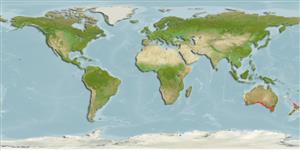Environment: milieu / climate zone / depth range / distribution range
पारिस्थितिकी
समुद्री ड़िमरसल; गहराई सीमा ? - 180 m (Ref. 9563). Temperate
Eastern Indian Ocean: endemic to southern Australia, from southern Western Australia to Victoria, including Tasmania.
आकार / वज़न / Age
Maturity: Lm ? range ? - ? cm
Max length : 25.0 cm TL पुल्लिंग / अलिंग; (Ref. 9563)
A schooling species found over rocky reefs (Ref. 9563).
Life cycle and mating behavior
परिपक्व अवधि | पुनरुत्पत्ति | मछलीऔ का अंडे देना | अंडे | Fecundity | लार्वा
May, J.L. and J.G.H. Maxwell, 1986. Trawl fish from temperate waters of Australia. CSIRO Division of Fisheries Research, Tasmania. 492 p. (Ref. 9563)
IUCN Red List Status (Ref. 130435: Version 2024-1)
Threat to humans
Harmless
Human uses
मात्स्यिकी: व्यापारिक
साधन
Special reports
Download XML
इंटरनेट स्रोत
Estimates based on models
Preferred temperature (Ref.
123201): 14.1 - 19.5, mean 16.6 °C (based on 187 cells).
Phylogenetic diversity index (Ref.
82804): PD
50 = 0.7500 [Uniqueness, from 0.5 = low to 2.0 = high].
Bayesian length-weight: a=0.01349 (0.00618 - 0.02945), b=3.00 (2.81 - 3.19), in cm total length, based on LWR estimates for this (Sub)family-body shape (Ref.
93245).
Trophic level (Ref.
69278): 3.6 ±0.5 se; based on size and trophs of closest relatives
लौटाव (Ref.
120179): माध्यम, न्यूनतम जनसंख्या दुगनी होने का समय 1.4 - 4.4 वर्ष। (Preliminary K or Fecundity.).
Fishing Vulnerability (Ref.
59153): Low vulnerability (15 of 100).
Nutrients (Ref.
124155): Calcium = 50.4 [27.1, 129.7] mg/100g; Iron = 0.464 [0.239, 0.949] mg/100g; Protein = 17.4 [15.4, 19.2] %; Omega3 = 0.695 [0.372, 1.295] g/100g; Selenium = 13.1 [6.3, 29.8] μg/100g; VitaminA = 28.4 [7.3, 116.9] μg/100g; Zinc = 0.65 [0.44, 0.98] mg/100g (wet weight);
